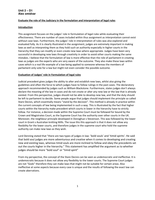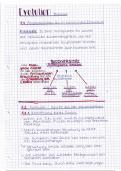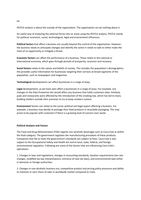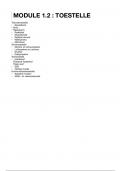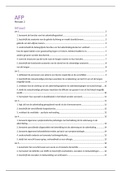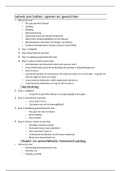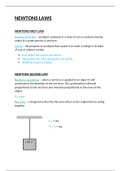Literature Week 3 – Governance and Strategy
Bovenkamp, Stoopendaal & Bal (2017) Working with layers: the governance and regulation of
healthcare quality in an institutionally layered system.
Institutional arrangements (consists of both instruments and actors) are built (layered) upon
preexisting arrangements. Institutional layering is a type of institutional change in which new
institutions are added on top of or alongside existing ones. Arrangements interact with each
other, which can lead to large and unpredictable transformations. These can have
consequences for the actors working in these arrangements. Actors have an important role
in playing change agents who strategically wish to bring about institutional change. Since rules
allow room for interpretation, debate, and contestation, actors can operate strategically in
their institutional environment, acting as change agents who can set in motion incremental
change.
Institutional work: strategic use of institutional context in order to bring about changes, and
the daily coping and keeping up with institutional structures. This daily work both works to
sustain and change prevailing institutional structures. This institutional work is enacted by
individuals and groups who can reproduce the roles assigned to them by their institutional
context but can also challenge, modify, and disrupt these roles.
Internal governance of a Dutch hospital: Board of Directors and Supervisory Boards. External
regulation: Health Inspectorate. These actors have been given responsibility for quality of
care as consequence of institutional layering.
Institutional theory argues that institutions are not static and do not only change through
exogenous shocks like equilibrium theory proposes, but incrementally change and evolve due
to both exogenous and endogenous sources of change. Four types of incremental change:
- Displacement: the removal of existing institutions and the introduction of new ones.
- Drift: the changed impact of existing institutions due to shifts in the environment.
- Conversion: the changed enactment of existing institutions due to their strategic
deployment.
- Layering: the introduction of new institutions on top of or alongside existing ones.
Institutional arrangements: state, market, civil society, professional community.
Governing mechanisms of these: regulation, contracts, consultation, self-regulation.
1
, Layering in Dutch healthcare
Quality of care was originally based on self-regulation by the professional community, using
instruments like medical education, peer review, clinical guidelines etc. This was
complemented by a limited amount of state regulation. Mainly to protect the boundaries of
the medical sphere. During the mid 80s there was discussion on how to reduce the rising
costs. End 80s the associational arrangement in which consultation with societal actors played
an important role in bringing about change (leading to several new legal arrangements). In
the 00s this wasn’t enough, so even more state regulation through the Inspectorate. This
happened along the implementation of the market-based system in which all Dutch citizens
are obliged to buy private health insurance. Transparency is key in this. All parties in hc
regulate it through competition and closing contracts on three markets: healthcare provision,
healthcare insurance and patients. Over the years became more layered. The different layers
interacts with each other (market based and different arrangements merge). Also resulted in
institutional drift, sine the impact of guidelines changed as result of shifts in the environment.
The market and the state have proven to be mutually reinforcing institutions.
The introduction of the Quality of Care Act in 1996 obligated healthcare organizations to have
a quality system in place and gave Boards of Directors the final responsibility for quality in
their hospital. The introduction of the Quality of Care act therefore affected the internal
governance of quality of care since it transferred responsibilities within hospitals from
professionals to the Board of Directors of healthcare organizations. The Healthcare
Inspectorate, as the external state regulator of quality of care, was meant to supervise
whether this responsibility was taken up in practice. At the same time, these actors have to
2
Bovenkamp, Stoopendaal & Bal (2017) Working with layers: the governance and regulation of
healthcare quality in an institutionally layered system.
Institutional arrangements (consists of both instruments and actors) are built (layered) upon
preexisting arrangements. Institutional layering is a type of institutional change in which new
institutions are added on top of or alongside existing ones. Arrangements interact with each
other, which can lead to large and unpredictable transformations. These can have
consequences for the actors working in these arrangements. Actors have an important role
in playing change agents who strategically wish to bring about institutional change. Since rules
allow room for interpretation, debate, and contestation, actors can operate strategically in
their institutional environment, acting as change agents who can set in motion incremental
change.
Institutional work: strategic use of institutional context in order to bring about changes, and
the daily coping and keeping up with institutional structures. This daily work both works to
sustain and change prevailing institutional structures. This institutional work is enacted by
individuals and groups who can reproduce the roles assigned to them by their institutional
context but can also challenge, modify, and disrupt these roles.
Internal governance of a Dutch hospital: Board of Directors and Supervisory Boards. External
regulation: Health Inspectorate. These actors have been given responsibility for quality of
care as consequence of institutional layering.
Institutional theory argues that institutions are not static and do not only change through
exogenous shocks like equilibrium theory proposes, but incrementally change and evolve due
to both exogenous and endogenous sources of change. Four types of incremental change:
- Displacement: the removal of existing institutions and the introduction of new ones.
- Drift: the changed impact of existing institutions due to shifts in the environment.
- Conversion: the changed enactment of existing institutions due to their strategic
deployment.
- Layering: the introduction of new institutions on top of or alongside existing ones.
Institutional arrangements: state, market, civil society, professional community.
Governing mechanisms of these: regulation, contracts, consultation, self-regulation.
1
, Layering in Dutch healthcare
Quality of care was originally based on self-regulation by the professional community, using
instruments like medical education, peer review, clinical guidelines etc. This was
complemented by a limited amount of state regulation. Mainly to protect the boundaries of
the medical sphere. During the mid 80s there was discussion on how to reduce the rising
costs. End 80s the associational arrangement in which consultation with societal actors played
an important role in bringing about change (leading to several new legal arrangements). In
the 00s this wasn’t enough, so even more state regulation through the Inspectorate. This
happened along the implementation of the market-based system in which all Dutch citizens
are obliged to buy private health insurance. Transparency is key in this. All parties in hc
regulate it through competition and closing contracts on three markets: healthcare provision,
healthcare insurance and patients. Over the years became more layered. The different layers
interacts with each other (market based and different arrangements merge). Also resulted in
institutional drift, sine the impact of guidelines changed as result of shifts in the environment.
The market and the state have proven to be mutually reinforcing institutions.
The introduction of the Quality of Care Act in 1996 obligated healthcare organizations to have
a quality system in place and gave Boards of Directors the final responsibility for quality in
their hospital. The introduction of the Quality of Care act therefore affected the internal
governance of quality of care since it transferred responsibilities within hospitals from
professionals to the Board of Directors of healthcare organizations. The Healthcare
Inspectorate, as the external state regulator of quality of care, was meant to supervise
whether this responsibility was taken up in practice. At the same time, these actors have to
2

